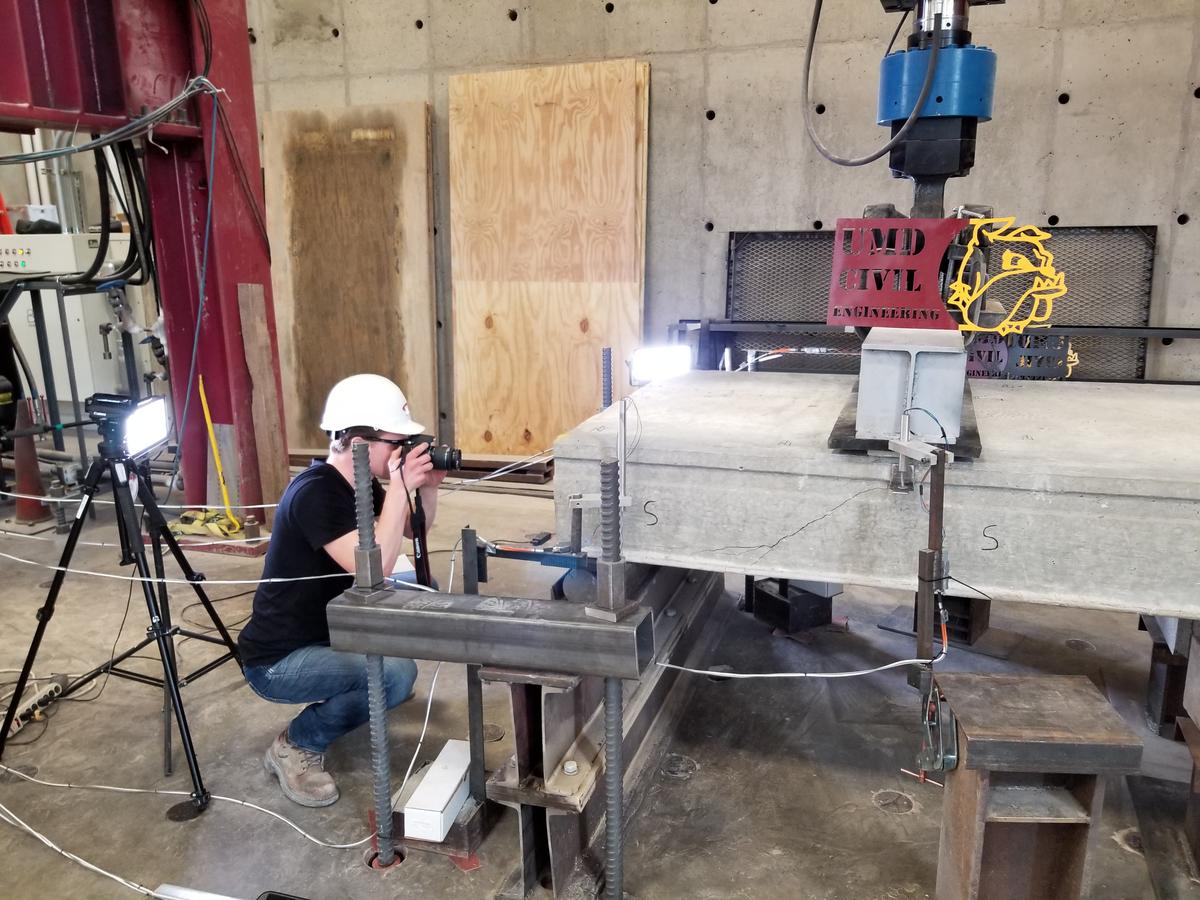Dr. Ben Dymond’s research team has grown! His graduate and UROP students have conducted a variety of internally and externally funded projects focused on the resiliency of reinforced and prestressed concrete infrastructure and structural systems.
M.S. Students L to R: Muhammad Bajwa, Connor Mills, Corin Treat, Matthew McDermott
Not pictured: Ethan Herberg (M.S.), Scott Asperheim (UROP), Kyle Nelson (UROP), and Sai Wu (UROP)
M.S. student Matthew McDermott is studying the shear capacity of precast, prestressed, extruded hollow-core slabs with partially filled cores via a PCI Daniel P. Jenny Fellowship. His project is investigating an alternative method to increase the shear capacity by breaking into the hollow-cores after fabrication and filling the ends with concrete. While this practice is already used in the industry, the applicability and reliability of typical code equations has not been studied. Matt plans to work as a structural engineer at Simpson Gumpertz & Heger Inc. in Boston after graduation.
M.S. students Muhammad Bajwa and Connor Mills are investigating the anchorage and bond of post-installed GFRP and epoxy-coated rebar, respectively. These alternatives to black rebar provide corrosion resistance, but their performance with industry standard chemical adhesives is not well documented. Muhammad has presented his work several times at ACI and has a paper accepted at the 9th International Conference on Fibre-Reinforced Polymer (FRP) Composites in Civil Engineering. Muhammad has applied to several schools to pursue a Ph.D. related to structural engineering after graduation.
M.S. student Corin Treat is investigating how various approaches to protect steel rebar and reduce concrete cracking have affected bridge deck degradation in Minnesota. To this end, bridges with epoxy-coated rebar top mats and uncoated black bar bottom mats (late 1970’s) and bridges with polypropylene fibers (2013 and later) have been built to increase the resiliency of the deck. Cori is using MnDOT inspection data and on-site visual inspections to address this question. Cori plans to work as a structural engineer at Meyer Borgman Johnson in Duluth after graduation.
M.S. student Ethan Herberg is expanding Dr. Dymond’s research portfolio and studying the flexural strength of nail-laminated timber crane mats in collaboration with the Natural Resources Research Institute and Savanna Pallets, Inc. of Duluth. These types of panels are often deployed as temporary roads in conjunction with the use of heavy construction equipment such as cranes (e.g., erection of power lines or oil and gas pipelines). The forest resource market in the Duluth area does not currently have a steady need for the underutilized, small diameter timber used in the fabrication of these NLT mats.
Dr. Dymond’s undergraduate research opportunity program (UROP) students have/are working on the following projects: Performance of Galvanized Reinforcing Steel in Concrete Bridges (Scott Asperheim), Effects of Ground Waste Glass on Portland Cement Concrete Beam Flexural Performance (Kyle Nelson in collaboration with Dr. Mary Christiansen), and Accurate Load Distribution Analysis for Extending Serviceability of the Blatnik Bridge via Field Load Testing (Sai Wu).
Dr. Dymond was the lead author on a successful PCI Foundation Precast Concrete Teaching Studio entitled “Resilient Precast in the Engineering Curriculum (RPEC).” This program is in collaboration with Dr. Mary Christiansen (CE), Dr. Andrea Schokker (CE), Dr. Allison Hoxie (MIE), the UMD MBA program, and Molin Concrete Products. RPEC has already brought significant scholarship money to UMD students, a hands-on precast concrete teaching demo in the CE high bay, and it will educate future leaders in the precast concrete industry.
